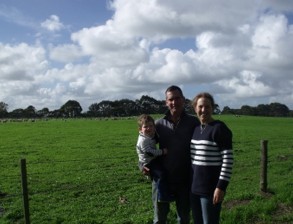Name:
Toby and Emily Hassell
Location:
‘Piccaninny’ Thornlea via Millicent
Average Rainfall:
600 mm
Enterprises:
3,500 ewes (first cross and composite ewes) + commercial Angus herd and cropping
Farm Area:
1100 hectares
Traditionally Toby’s approach to worming has been the two-summer drench approach, which can be ineffective when summer rainfall occurs in the winter rainfall areas of Southern Australia.
The ewe flock was drenched in November or December with a second drench given in February or March. Weaners were drenched at weaning in September with a second drench given based on visual signs, such as scouring. Rams were drenched pre-joining.
Following conversations with fellow producers and animal health advisors, and concerns with running out of drench group options, Toby decided to rethink his approach to worm management.
In recent years, Toby has undertaken feacal egg counts as part of his program. He collects approximately 10 samples per mob by cornering the sheep in a paddock and collecting the samples.
“It’s not hard and only takes about 10 or 15 minutes per mob.” Toby Hassell
He starts this in November instead of yarding and drenching. His decision to drench or not is based on the result reported in eggs per gram. He also makes his decision based on the worm species present. He will then retest 6-8 weeks later and make a decision to drench or not. Toby said his decision to drench “varies between classes or stock, the season, and individual mobs”. He adds “sometimes the eggs per gram can fluctuate and even drop without administering a drench”.
Toby has always given a pre-lambing drench and continues to do so. He uses his most effective drench then, as he feels the ewes are ‘at their most stressed period for the year and it’s the most important drench’.
 Toby, Emily and Family
Toby, Emily and FamilyEwes are set stocked for lambing. In some years, Toby will undertake a pre-marking feacal egg count to determine if a drench at marking is required.
Toby uses the online resource ‘WormBoss’ for information and to help with his drench decisions and other worm management strategies. He finds the website very useful and easy to use.
Since undertaking feacal egg counts Toby has reduced his need to drench and has stopped drenching his sheep unnecessarily. In some years depending on the season he has not needed to drench at all. Toby chooses his drench based on the types of worms his sheep are carrying, as well as being mindful of rotating drench groups.
While minerals are generally less important than protein and energy to a sheep’s resistance and resilience to worms, minerals do play a role in areas where deficiencies occur. Research has shown that copper and cobalt can impact on the establishment or susceptibility of a sheep to worms. Toby provides a loose lick mineral mix to his flock to help improve not only worm management but overall health.
Preparing weaning paddocks is also an essential part of Toby’s worm management program. Weaning paddocks are spelled for 4 months prior to weaners grazing them. Depending on seasonal conditions and temperature, over 90% of worm larvae die in 2-6 months.
Toby believes the biggest benefits have been reduced labour, reduced use of chemical, and a reduction in the potential resistance issue with more strategic use of chemical. While Toby has not measured improved weight gains, he believes that the new strategic approach would be improving production and reducing costs within his sheep enterprise.
The next step for Toby is to look at undertaking resistance testing to confirm the drenching strategy is the most effective and the current chemicals are still effective.
Further information: WormBoss http://www.wormboss.com.au/
Prepared by Tiffany Bennett, Primary Industries and Regions SA: Rural Solutions SA (2018).